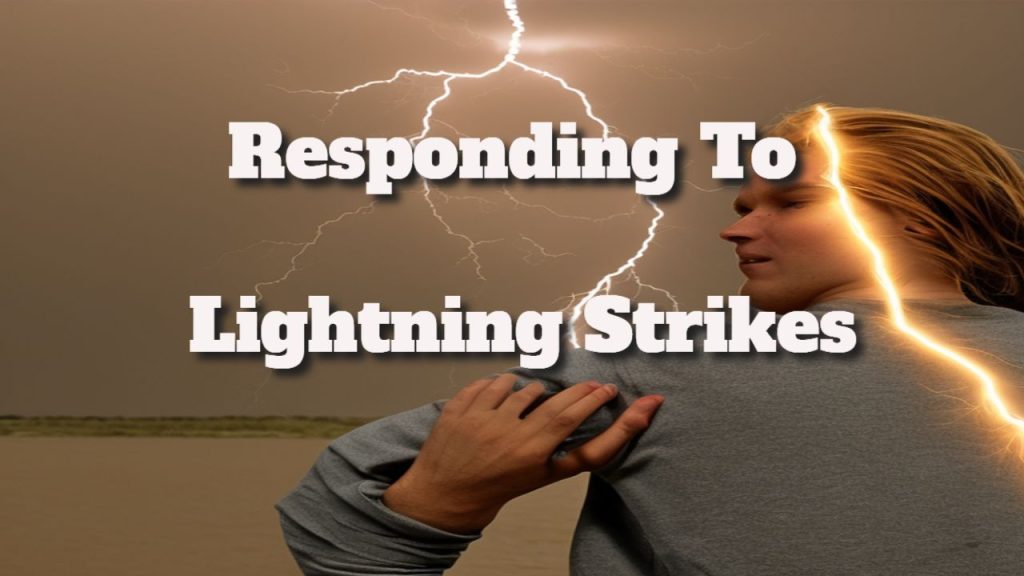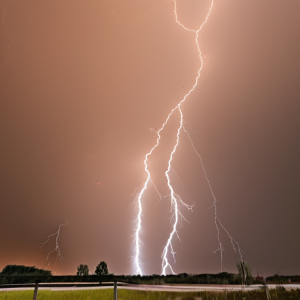Protection From Lightning Strikes.
Recognising lightning
Lightning is an enthralling and powerful natural force that can both awe and astonish. It is, however, a harmful phenomenon that must be understood to assure safety. This understanding is a firm foundation for the safety techniques covered in the following chapters.
Lightning is an electrical discharge that occurs during a thunderstorm. It is caused by the atmosphere’s accumulation and discharge of static electricity.
Charges split as water droplets and ice particles hit in thunderclouds; positively charged particles ascend to the cloud’s surface, while negatively charged particles descend to the bottom. This charge separation sets the stage for a spectacular lightning storm.
There are different types of lightning, each with its characteristics. The most common type of lightning is cloud-to-ground lightning, which extends from the base of a thundercloud to the earth’s surface.
This type of lightning is notorious for its destructive force and can strike quickly and intensely. Cloud-to-cloud lightning is another type that occurs between different areas of the same storm cloud.
This type of lightning frequently brightens the sky with spectacular flashes, producing a captivating visual spectacle.
Even as the beauty of lightning enthrals us, we must be wary of its risks.
Lightning strikes can cause severe harm or even death. This natural tragedy kills thousands of people globally each year.
Due to its ability to carry a charge for kilometres, lightning can strike even when a storm appears miles distant. Understanding lightning threats is crucial for our safety.
With this extra information, we can better judge the value of proactive safety actions. We can empower ourselves with instruments to lessen the hazards associated with lightning’s existence if we better understand its intricacies.
As we go deeper into the world of lightning, we must study the different components that lead to lightning formation. Thunderstorms are the most common lightning source because they provide the necessary ingredients: moisture, unstable air, and an updraft.
Combining these ingredients results in a stunning electrical discharge. Thunderstorms are common in hot, humid environments when rising, heated air collides with colder air.
The collision of these air masses creates the conditions for the formation of thunderclouds, which is essential for lightning.
The movement of air within a thunderstorm cloud is critical. Updrafts within the cloud meet, resulting in the collision of small ice particles and water droplets and the splitting of charges. This charge separation starts the complex process that leads to lightning.
A solid electric field emerges as positive and negative charges build in the cloud. When the electric field becomes too powerful, it causes a discharge and lightning.
The ability of lightning to illuminate the intricate intricacy of our surroundings is impressive. Different colours of lightning can reveal the composition of storm clouds.
For example, blue or purple lightning indicates the presence of ice particles in the cloud, but yellow or red lightning shows the presence of dust or pollution in the cloud. By observing these characteristics, Scientists can better understand the atmospheric conditions that encourage lightning formation.
While watching the hypnotic beauty of lightning is fascinating, it is essential to keep the hazards of this stunning natural phenomenon in mind. Lightning strikes with astonishing speed, and its devastating potential should never be underestimated.
The second half of this chapter looks at the various safety strategies crucial to our safety during a lightning strike.
By arming ourselves with knowledge and adopting proactive actions, we can lessen the dangers and protect ourselves against lightning strikes. Let’s embark on this journey together and learn the secrets of lightning strike safety.
Precautions to Take If Lightning Strikes
When lightning, a powerful natural force, strikes quickly and unexpectedly, everybody is at risk.
Safety protocols and precautions must be followed to ensure safety during a lightning strike. As a result, we can lower our chances of being struck by lightning and protect ourselves and others.
When a thunderstorm approaches, staying indoors is the first and most important precaution. This offers the most protection against a lightning strike. Seek refuge in a strong structure, preferably equipped with a lightning protection system.
Avoid open garages, picnic shelters, and other buildings that may not provide adequate protection. Stay away from windows, doors, and electrical equipment during a thunderstorm.
Find an appropriate temporary shelter if indoor shelter is not possible. Avoid seeking cover behind lone trees, vast fields, or massive metal constructions.
Seek a low-lying area away from potential lightning rods and lie flat with your hands over your ears to reduce the likelihood of a direct lightning strike.
You should also be familiar with the lightning safety guidelines for varied conditions. Check the weather forecast first if you intend to spend time outside, such as hiking, golfing or swimming.
Seeking cover or avoiding being outside during a thunderstorm can significantly reduce your risk of being struck by lightning.
Remember that lowering your risk of being struck by lightning is critical for your safety. When struck by lightning, we can effectively protect ourselves and others by staying home, obtaining proper shelter, and learning the lightning strike safety suggestions.
However, the precautions do not stop there. By following these precautions, individuals can lower their chances of being struck by lightning and ensure their safety in the event of a lightning strike.
It is critical to avoid contact with water during rainfall. Because water is a good conductor of electricity, being in or near water increases the risk of a lightning strike.
If you’re swimming, boating, or doing anything else in the water, leave immediately if you hear thunder or see lightning. Until the storm passes, stay inside or in a fully enclosed vehicle.
Furthermore, understanding the “30-30 rule” is crucial for storm safety.
If there is less than 30 seconds between seeing lightning and hearing thunder, go inside and seek cover immediately.
It is also recommended that you leave the safety of a stationary building or vehicle at least 30 minutes after the last lightning or thunderclap.
It is vital to have an action plan for outdoor sports and recreational activities. Coaches, organisers, and players should set clear standards for avoiding lightning hazards.
If thunderstorms are forecasted or are imminent, all activities must be halted, and all participants must be relocated to a safe location.
Outdoor athletic events, such as golf tournaments or football matches, can be rescheduled or postponed to avoid undue risks.
Educating children, teens, and adults about lightning safety at home and in schools is vital.
People who are educated on the dangers of lightning and fundamental safety procedures can make better decisions and protect themselves during thunderstorms.
A combination of practical safety measures, safeguards, and clever techniques is required to protect safety during a thunderstorm disaster.
We may reduce our chances of getting struck by lightning and protect ourselves and others by avoiding water during thunderstorms, following the 30-30 rule, making action plans for outdoor activities, and increasing lightning safety awareness.
Maintain vigilance and educate yourself because your safety and those around you should always come first.
Reaction to Lightning Strikes
Lightning strikes are unpredictable and might risk our lives. You must learn proper behaviour norms, such as first aid practices, calling for help, and supporting injured people.
In a lightning strike, the priority should be personal safety. If you are outside during a thunderstorm, seek shelter immediately.
Avoid broad open regions, tall, isolated structures, and bodies of water that operate as lightning conductors. Seek safety in a solid structure or a fully enclosed vehicle with windows covered. Avoid seeking cover under trees or in makeshift structures, as these offer little protection.
You must adhere to the safety criteria once you’ve chosen a good shelter. Electrical appliances, sanitary facilities, and telephones can conduct electricity.
Showering or bathing during a thunderstorm is not advised because water conducts electricity well. Avoid them because lightning can pass through windows, doors, and concrete walls.
If a person is struck by lightning, immediate action is essential. Examine the person’s pulse and respiration. If not, dial 911 and, if qualified, commence cardiopulmonary resuscitation (CPR).
Resuscitation should begin as soon as possible to improve the chances of survival. If the sufferer is conscious but hurt, help them initially while they await medical treatment.
Remember that in the event of a lightning strike, time is critical—every second counts. Maintain your composure, move quickly, and take the necessary precautions to protect the safety of all parties. If we understand the protocols and how to react appropriately, we can protect ourselves and those around us from the dangers of a lightning strike.
So, armed with this knowledge, we will be ready in the event of a lightning strike. In these critical situations, we will look at advanced first-aid protocols and the need to be informed and connected.
Be prepared for the unexpected since it can occur in the blink of an eye. Being prepared and aware of a lightning strike is crucial for our and others’ safety.
By being knowledgeable with advanced first aid skills and remaining educated in critical situations, we can improve our ability to respond and reduce potential risks.
When providing first aid to someone struck by lightning, it is vital to proceed with caution. Even if there is no visible evidence of a lightning strike, it can result in serious burns and internal trauma.
First, check the sick person’s airway, breathing, and circulation. If the person is not breathing or has no pulse, call 911 immediately and, if certified, commence cardiopulmonary resuscitation (CPR).
Remember that resuscitation as soon as possible will considerably boost your chances of survival.
While you wait for medical assistance, give close attention to anyone who is unconscious but injured. Keep in mind the four primary objectives in such situations:
Immobilise the individual.
Keep your body temperature stable.
Avoid further injury.
Send the patient to a medical facility as soon as possible.
If the person is having trouble breathing, has burns, or is feeling chest pain, get medical treatment immediately.
Discuss how important it is to be informed and connected during a lightning strike. Weather conditions can change quickly, and being aware of impending severe weather is crucial for taking protective measures.
Check weather forecasts frequently, listen to local news, or utilise weather apps to get early warnings of severe weather. Stay in touch with your family, friends, or colleagues to ensure everyone knows the safety protocols and can aid if needed.
Knowing advanced first aid protocols and staying up to date on lightning strikes allow us to respond quickly and safeguard the safety of those in danger.
Remember that lightning strikes are unpredictable, but we can protect ourselves by arming ourselves with knowledge and keeping watchful. Keep yourself safe, knowledgeable, and prepared for the unexpected.
The post Protection From Lightning Strikes appeared first on Survival Avenue.
The post Protection From Lightning Strikes appeared first on https://gqcentral.co.uk




Comments are closed